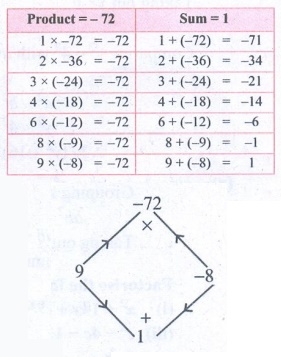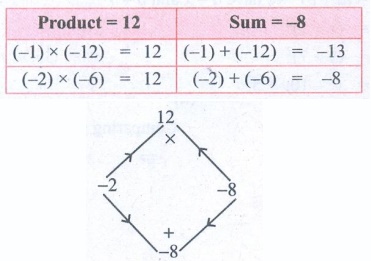Questions with Answers, Solution | Algebra | Chapter 3 | 8th Maths - Exercise 3.4 (Factorisation) | 8th Maths : Chapter 3 : Algebra
Chapter: 8th Maths : Chapter 3 : Algebra
Exercise 3.4 (Factorisation)
Exercise
3.4
1. Factorise the following by taking
out the common factor
(i) 18xy −12 yz
(ii) 9x 5 y 3
+ 6x 3 y2 −18x 2 y
(iii) x (b − 2c ) + y(b − 2c)
(iv) (ax + ay)
+ (bx + by)
(v) 2x 2 (4x − 1)
− 4x + 1
(vi) 3y (x − 2)2
− 2(2
− x)
(vii) 6xy − 4 y 2 + 12xy − 2 yzx
(viii) a 3 − 3a2 + a
− 3
(ix) 3y 3 − 48 y
(x) ab2 − bc2
− ab + c2
Solution:
(i) 18xy − 12yz = (2 × 3 × 3 × y × x) − (2 × 2 × 3 × y × z)
Taking out the common factors 2, 3, y, we get
= 2 × 3 × y (3x − 2z) = 6y (3x
− 2z)
(ii) 9x5 y3 + 6x3y2
– 18x2y = (3 × 3 × x2 × x3
× y × y2) + (2 × 3 × x2 × x ×
y × y) − (2 × 3 × 3 × x2 × y)
Taking out the common factors 3, x2, y,
we get
= 3 × x2 × y (3x3 y2
+ 2xy − 6)
= 3x2y (3x3 y2
+ 2xy − 6)
(iii) x(b − 2c) + y (b − 2c)
Taking out the binomial factor (b − 2c) from each
term, we have
= (b − 2c) (x + y)
(iv) (ax + ay) + (bx + by)
Taking at ‘a’ from the first term and ‘b’ from the
second term we have
(ax + ay) + (bx + by) = a (x + y) + b (x +
y)
Now taking out the binomial factor (x + y) from
each term
= (x + y) (a + b)
(v) 2x2(4x − 1) − 4x + 1
Taking out −1 from last two terms
2x2(4x − 1) − 4x + 1 = 2x2 (4x − 1) − 1
(4x − 1)
Taking out the binomial factor 4x − 1, we get
= (4x − 1) (2x2 − 1)
(vi) 3y (x − 2)2 – 2 (2 − x)
3y (x − 2)2 – 2 (2 − x) =
3y (x − 2) (x − 2) – 2 (−l) (x − 2)
[∵ Taking out −1 from 2 − x]
= 3y (x − 2) (x − 2) + 2(x − 2)
Taking out the binomial factor x − 2 from each term, we
get
= (x − 2) [3y (x − 2) + 2]
(vii) 6xy − 4y2 + 12xy − 2yzx
6xy + 12xy − 4y2 − 2yzx [∵ Addition is commutative]
= (6 × x × y) + (2 × 6 × x × y) + ((−1)
(2) (2) y + y) + ((−l) (2) (y) (z) (x))
Taking out 6 × x × y from first two terms and (−1)
× 2 × y from last two terms we get
= 6 × x × y ( l + 2) + (−l) (2) y [2y
+ zx]
= 6xy (3) − 2y (2y + zx)
= (2 × 3 × 3 × x × y) − 2xy (2y + zx)
Taking out 2y from two terms
= 2y (9x − (2y + zx)) = 2y (9x
−2y − xz)
(viii) a3 − 3a2 + a – 3 = a2 (a − 3)
+ 1 (a − 3) [∵ Grouping the terms suitably]
= (a − 3) (a2 + 1)
(ix) 3y3 – 48y = 3 × y × y2
− 3 × 16 × y
Taking out 3 × y
= 3y (y2 − 16) = 3y (y2
− 42)
Comparing y2 − 42 with a2
− b2
a = y, b = 4
a2 − b2 = (a + b) (a − b)
y2 − 42 = (y + 4) (y − 4)
∴ 3y (y2
– 16 ) = 3y (y + 4) (y − 4)
(x) ab2 − bc2 − ab + c2
Grouping suitably
ab2 − bc2 − ab + c2 = b
(ab − c2) − 1 (ab − c2)
Taking out the binomial factor ab − c2
= (ab − c2) (b − 1)
2. Factorise the following expressions
(i) x 2 + 14x + 49
(ii) y 2 − 10 y + 25
(iii) c 2 − 4c −12
(iv) m2 + m
− 72
(v) 4x 2 − 8x + 3
Solution:
(i) x2 + 14x + 49 = x2
+ 14x + 72
Comparing with a2 + 2ab + b2
= (a + b)2 we
have a = x, b = 7
⇒ x2 + 2(x)(7) + 72 = (x
+ 7)2
∴ x2 + 14x + 49 =
(x + 7)2
(ii) y2 – 10y + 25 = y2 – 10y + 52
Comparing with a2 − 2ab + b2
= (a − b)2 we
have a = y, b = 5
⇒ y2 + 2(y)(5) + 52 = (y
− 5)2
∴ y2 – 10y + 25 = (y
− 5)2
(iii) c2 − 4c − 12
This is of the form ax2 + bx + c
Where a = l, b = −4 c = −12, x = c
Now the product ac = 1
× − 12 = −12 and the sum b = − 4
Product = − 72 : Sum = 1
1 × (−12) = −12 : 1 + (−12)
= −11
2 × (−6) = −12 : 2 + (−6) = −4
∴ The middle term − 4c can be written as 2c − 6c

∴ c2 − 4c − 12 = c2 + 2c − 6c
− 12
= c (c + 2) − 6 (c + 2)
Taking out (c + 2)
=> (c + 2) (c − 6)
∴ c2 − 4c − 12 = (c + 2) (c − 6)
(iv) m2 + m − 72
This is of the form ax2 + bx + c

where a = 1, b = l, c = −72
Product a × c = l × −72 = −72
Sum b = 1
The middle term m can be written as 9m − 8m
m2 + m – 72 = m2
+ 9m – 8m – 72
= m (m + 9) – 8 (m + 9)
Taking out (m + 9)
= (m + 9) (m − 8)
∴ m2 + m – 72 = (m + 9) (m − 8)
(v) 4x2 − 8x + 3
This is of the form ax2 + bx + c
with a = 4 b = − 8 c = 3
Product ac = 4 × 3
= 12
sum b = − 8

The middle term can be written as − 8x = −2x − 6x
4x2 − 8x + 3 = 4x2 − 2x
− 6x + 3
= 2x (2x − 1) − 3 (2x − 1)
= (2x − l) (2x − 3)
4x2 – 8x + 3 = (2x − l) (2x − 3)
3. Factorise the following expressions
using (a + b)3 = a 3 + 3a2b + 3ab 2 + b3
identity
(i) 64x3+144x2
+ 108x+27
(ii) 27p3+54p2q+36pq2+8q3
Solution:
(i) 64x3 + 144x2 + 108x +
27
= (4x)3 + 3(4x)2 (3) + 3(4)
(3)2 + 33
= (4x + 3)3
(ii) 27 p3 + 54p2q + 36pq2
+ 8q3
= (3p)3 + 3(3p)2 (2q)
+ 3(3p) (2q)2 + (2q)3
= (3p + 2q)3
4. Factorise the following expressions
using (a − b)3 = a 3 − 3a2b + 3ab 2 − b3
identity
(i) y3–18y2+108y–216
(ii) 8m3–60m2n+150mn2–125n3
(i) y3 – 18y2 + 108y − 216 = y3
– 3y2(6) + 3(6)2y − 63
= (y − 6)3
(ii) 8m3 – 60 m2n + 150mn2
– 125 n3
= (2m)3 − 3(2m)2 (5) + 3(2m)
(5n)2 − (5n)3
= (2m – 5n)3
Objective
type Questions
5. Factors of 9x2+6xy are
(A) 3y, (x+2)
(B) 3x, (3x+3y)
(C) 6x, (3x+2y)
(D) 3x, (3x+2y)
[Answer: (D) 3x, (3x + 2y)]
Solution:
9x2 + 6xy = 3x (3x + 2y)
6. Factors of 4–m2 are
(A) (2+m)(2+m)
(B) (2–m)(2–m)
(C) (2+m)(2–m)
(D) (4+m)(4–m)
[Answer: (C) (2 + m) (2 − m)]
Solution: 4 – m2 = 22
− m2
= (2 + m) (2 − m)
7. (x+4) and (x–5) are the factors
of ___________
(A) x2–x+20
(B) x2–9x–20
(C) x2+x–20
(D) x2–x–20
[Answer: (D) x2 – x – 20]
Solution:
(x + 4) (x − 4) = x (x) + 4 (−5) + x
(−5) + 4(x)
= x2 − 20 − 5x + 4x
= x2 − x − 20
8. The factors of x2–5x + 6 are (x–2)(x–p) then the value of p is _________
(A) –3
(B) 3
(C) 2
(D)–2
[Answer: (B) 3]
Solution:
x2 − 5x + 6 = x2 −3x − 2x
+ 6
= x (x − 3) – 2 (x − 3)
= (x − 3) (x − 2)
= (x − p) (x − 2)
p = 3
9. The factors of 1–m3
(A) (1+m), (1+m+m2)
(B) (1–m), (1–m–m2)
(C) (1–m), (1+m+m2)
(D) (1+m), (1–m+m2)
[Answer: (C) (1 − m), (1 + m + m2)]
Solution:
a3 – b3 = (a − b) (a2
+ ab + b2)
1 – m2 = (1 − m) (1+ m + m2)
10. One factor of x3+y3 is
(A) (x – y)
(B) (x + y)
(C) (x + y)3
(D) (x – y)3
[Answer: (B) (x + y)]
a3 + b3 = (a + b) (a2
− ab + b2)
x3 + y3 = (x + y) (x2
− xy + y2)
Answer:
Exercise 3.4
1. (i ) 6 y (3
x − 2z) (ii) 3 x2y(3x3 y2 + 2xy − 6) (iii)
(b − 2c )( x + y)
(iv) ( x + y)(
a + b) ( v ) ( 4 x − 1)( 2 x2 −1)
( vi) ( x − 2)[3 y(x − 2) + 2]
(vii ) 2y(9x − 2 y − zx)
( viii) ( a − 3) ( a2 +1) (ix) 3y (
y + 4)( y − 4) (x) (b − 1)(ab − c2
)
2. (i ) (x + 7)2
(ii) ( y − 5)2 (iii ) ( c +
2)( c − 6) (iv) ( m + 9)( m − 8) (v) ( 2 x − 3)( 2 x −1)
3. (i) (4x + 3)3
(ii) (3p + 2q)3
4. (i) ( y − 6)3 (ii) ( 2 m − 5n)3
5. (D) 3x, (3x+2y)
6. (C) (2+m)(2–m)
7. (D) x2–x–20
8. (B) 3
9. (C) (1–m)(1+m+m2)
10. (B) (x+y)